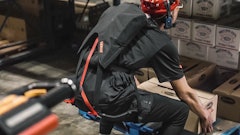
The summer of 2023 came in hot, making history along the way. With record-breaking heat waves scorching the globe, the need to prioritize worker safety, especially for those in the food manufacturing industry, has never been more crucial.
This year has been a record-breaking year for extreme heat, with more excessive heat warnings issued than ever before. July was also the hottest month on record globally, according to NASA and Copernicus Climate Change scientists. Further, hotter temperatures are extending past traditional summer months. In fact, the 10 warmest years on record have all occurred since 2010, according to NOAA’s National Centers for Environmental Information. While outdoor workers are often recognized as being at risk during such extreme conditions, it's important to remember that indoor employees without air conditioning are also vulnerable to the dangers of excessive heat.
Understanding heat-related risks
Even workers shielded from direct sunlight can suffer from heat strain due to their metabolic heat load, which becomes more pronounced in high temperatures. Without air movement, cooling off becomes challenging. Dehydration and heat cramps are real possibilities, even with proper cooling systems in place.
Proactive measures for worker safety
To mitigate these risks, here are some proactive measures for employers:
1. Clear procedures. Establish clear and accessible protocols for employees to seek immediate medical assistance if needed. Regularly update and communicate these procedures to all staff.
2. Recognize the signs. Ensure that personnel are trained to recognize the signs of heat-related illnesses and respond appropriately. This includes up-to-date training on first aid and proper responses to heat-related emergencies.
3. Monitor the heat index. Keep a close eye on the daily heat index and plan accordingly. The Occupational Safety and Health Administration (OSHA) recommends using the heat index as a screening tool to assess the heat's impact on workers.
4. Ventilation matters. Ensure proper ventilation within the facility. While it may be challenging to ventilate large spaces entirely, the use of portable fans, ceiling fans, exhaust fans and dehumidifiers can help maintain a cooler environment.
5. Insulate hot pipes. Heat can radiate from indoor pipes, so insulating them can contribute to a more comfortable workplace.
6. Equipment maintenance. Regularly inspect and maintain equipment to prevent overheating.
7. Encourage rest breaks. While it might seem like productivity will suffer, exhaustion and heat-related problems can halt work entirely. Encourage scheduled rest breaks.
8. Open communication. Encourage employees to voice their concerns. Consider wearable devices that monitor stress, exhaustion, humidity and temperature.
9. Acclimatization. Implement acclimatization schedules for new and long-term employees, including adjustments for the hottest part of the day and re-acclimatization after vacations. Follow recommendations by NIOSH.
10. Hydration stations. Offer hydration stations and ensure staff know their locations.
11. Proper clothing. Recommend loose-fitting, light-colored clothing in natural fibers, along with hats to protect against the sun.
12. Additional workers. Provide additional personnel for tasks requiring greater physical exertion.
13. Meal choices. Encourage employees to choose meals wisely, avoiding high-calorie options in extreme heat.
14. Maintain safety routines. Don't let extra precautions for heat distract from regular safety practices.
Quantifying heat stress and heat strain
Preventing heat strain-related illnesses such as heat stroke and heat exhaustion is often complicated because of the many variables that compound the heat stress imposed on a worker's body.
Heat stress includes a worker's physical exertion and adjusting to environmental factors like air temperature, humidity, air movement, and clothing worn. It's essential to understand these factors when assessing worker safety.
Heat strain, on the other hand, is an individual's physiological response to heat stress. Managers and supervisors should be trained in recognizing and preventing heat strain illnesses.
Heat index and acclimatization
Although OSHA does not have a heat stress standard, they recommend using the heat index as a screening tool. The heat index adjusts temperature based on relative humidity and other factors. To account for additional risks like direct sun exposure and strenuous workload, employers must be cautious when using the heat index. Acclimatization is a gradual process of adaptation to heat conditions involving sweating, heart rate, blood flow and temperature regulation.
Employers can manage acclimatization by following recommended schedules and adjusting work hours to avoid the hottest part of the day.
Clothing and staying cool. Encouraging the use of single-layer, light-colored and breathable clothing can aid in heat regulation. Proper clothing allows for the evaporation of sweat, the predominant heat removal mechanism.
Quantifying heat stress via heat hazard assessments. Various tools are available for quantifying heat stress, such as OSHA/NIOSH's heat safety tool and comprehensive assessments like the wet bulb globe temperature. These tools consider factors like air movement, radiant heat and temperature, providing a comprehensive view of heat stress risk.
Heat strain prevention. To prevent heat strain, consider elements like acclimatization schedules, proper clothing, hydration, work/rest regimens, environmental monitoring, trained supervisors, extra workers for physically demanding tasks and the availability of supplies and medical personnel.
In these sweltering times, prioritizing the safety and well-being of employees is crucial. Ensure that they stay cool, healthy and productive, even in the face of record-breaking heat.
Prioritizing worker safety in the face of a sweltering challenge. As you navigate record-breaking heat waves and soaring temperatures, safeguarding food industry workers becomes an urgent matter. The alarming increase in excessive heat warnings and July's confirmation as the hottest month on record worldwide underscore the gravity of the situation. It's crucial to remember that even indoor employees, lacking adequate cooling, face perilous conditions.
While the proactive measures outlined above can significantly reduce heat-related risks, they cannot eliminate them entirely. This is where a robust workers' compensation plan steps in as a vital safety net.
The crucial role of workers’ compensation plans. Working closely with an insurance provider to establish a comprehensive workers' compensation plan is of paramount importance. The scorching summer, with its relentless heat, places an unprecedented burden on both employers and their workforce. A well-structured workers' compensation plan not only provides financial protection for employees in case of work-related injuries or illnesses but also offers peace of mind to both employers and workers. It ensures that medical expenses, rehabilitation costs, and lost wages are covered, thereby alleviating the financial strain that can result from heat-related incidents.
Collaborating with a reputable insurance provider allows businesses in the food industry to tailor their workers' compensation plans to specific needs. This includes accounting for the unique challenges posed by extreme heat and ensuring that employees are adequately protected.
In these challenging conditions, safeguarding worker safety isn't just a regulatory requirement; it's a moral and ethical obligation. By working in tandem with insurance providers to fortify a workers' compensation plan, you demonstrate a commitment to employees' well-being and fortify the business against the potential financial repercussions of heat-related incidents.


























